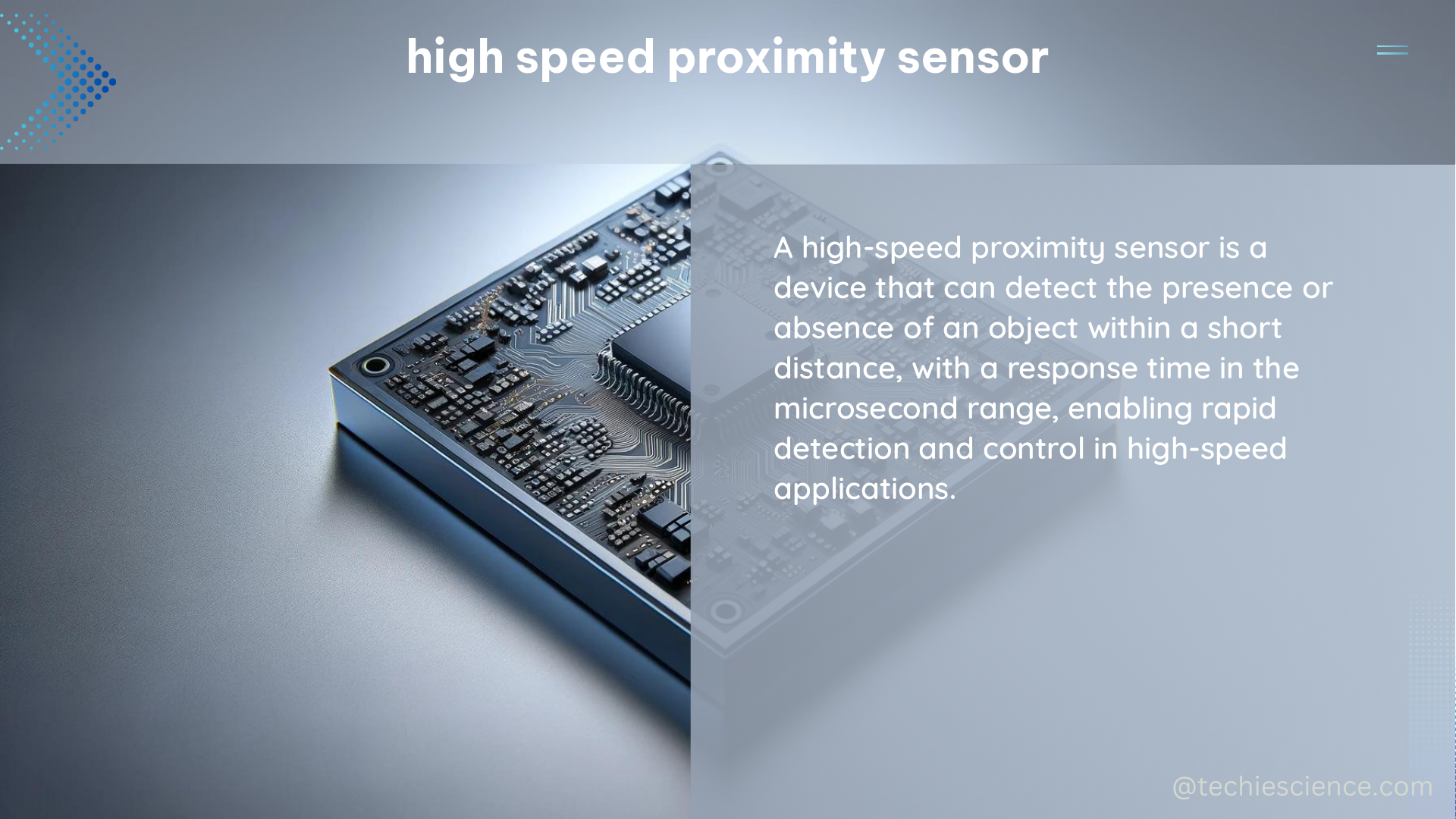High speed proximity sensors are advanced devices that can detect and measure the presence, distance, or position of objects at lightning-fast speeds, enabling real-time decision-making and efficient operations in various industries, from military surveillance to autonomous vehicles.
Technical Specifications of High Speed Proximity Sensors
-
Data Transfer Rate: High speed proximity sensors can transfer data at rates up to 10 gigabits per second (Gbps), allowing for rapid detection and response to changing conditions. This is achieved through the use of advanced communication protocols, such as Ethernet, SerDes (Serializer/Deserializer), and LVDS (Low-Voltage Differential Signaling).
-
Measurement Frequency: These sensors can measure the proximity of objects at frequencies ranging from 10 kilohertz (kHz) to 100 megahertz (MHz), ensuring accurate and timely data. This high-frequency operation is made possible by the use of specialized analog-to-digital converters (ADCs) and digital signal processing (DSP) techniques.
-
Sensing Range: The sensing range of high speed proximity sensors can vary from a few centimeters to several meters, depending on the specific technology and application. For example, ultrasonic sensors can detect objects at distances up to 10 meters, while radar-based sensors can operate at ranges of up to 100 meters.
-
Environmental Sensing: High speed proximity sensors can detect and analyze various environmental factors, such as geographic location, electromagnetic interference, and temperature, to ensure accurate and reliable operation. This is achieved through the integration of additional sensors, such as GPS, magnetometers, and temperature sensors, as well as advanced data fusion algorithms.
-
Data Fusion and Analytics: These sensors can fuse data from multiple sources, including other sensors and data streams, to provide a comprehensive understanding of the environment and objects within it. They can also perform advanced analytics, such as predictive modeling and anomaly detection, to support decision-making. This is enabled by the integration of powerful microprocessors, field-programmable gate arrays (FPGAs), and machine learning algorithms.
-
Integration and Compatibility: High speed proximity sensors can be integrated with various systems and platforms, including industrial control systems, autonomous vehicles, and military radar systems. They are also compatible with a wide range of communication protocols, such as Ethernet, CAN bus, and RS-232/485, ensuring seamless integration and operation.
-
Security and Privacy: These sensors can incorporate advanced security features, such as encryption, access controls, and secure boot, to protect sensitive data and ensure privacy. This is particularly important in applications where the sensor data may contain sensitive information or be used for critical decision-making.
DIY High Speed Proximity Sensor

Building a high speed proximity sensor requires a deep understanding of electronics, programming, and data analysis. However, with the right resources and tools, it is possible to create a functional prototype. Here are the general steps to build a high speed proximity sensor:
-
Select a Sensing Technology: Choose the appropriate sensing technology for your application, such as ultrasonic, infrared, or radar. Each technology has its own advantages and disadvantages, so it’s essential to carefully evaluate the requirements of your project.
-
Design the Sensor Circuit: The sensor circuit should include the sensing element, signal conditioning circuits, and data acquisition systems. This may involve the use of specialized integrated circuits (ICs), such as high-speed ADCs, operational amplifiers, and analog switches. The design should also consider the power supply, communication interfaces, and protection features.
-
Program the Microcontroller: Select a high-performance microcontroller, such as an ARM Cortex-M or RISC-V-based processor, and program it to control the sensor circuit, acquire and process the sensor data, and communicate with other systems or platforms. The programming language and tools will depend on the specific microcontroller and application.
-
Test and Calibrate the Sensor: Thoroughly test and calibrate the sensor to ensure accurate and reliable operation. This may involve adjusting the sensing range, measurement frequency, and environmental sensing capabilities, as well as implementing advanced calibration techniques, such as Kalman filtering and sensor fusion.
-
Integrate and Operate the Sensor: Once the sensor is tested and calibrated, integrate it with other systems or platforms and operate it in the specific application. Continuously monitor and maintain the sensor to ensure optimal performance and longevity.
Conclusion
High speed proximity sensors are a critical component in a wide range of applications, from military surveillance to industrial automation and autonomous vehicles. By understanding the technical specifications and building a DIY high speed proximity sensor, you can unlock new possibilities in your projects and push the boundaries of what’s possible with advanced sensing technologies.
References
- DoD SBIR 23.1
- Leveraging Industrial IoT and advanced technologies for digital transformation
- Sensors for daily life: A review

The lambdageeks.com Core SME Team is a group of experienced subject matter experts from diverse scientific and technical fields including Physics, Chemistry, Technology,Electronics & Electrical Engineering, Automotive, Mechanical Engineering. Our team collaborates to create high-quality, well-researched articles on a wide range of science and technology topics for the lambdageeks.com website.
All Our Senior SME are having more than 7 Years of experience in the respective fields . They are either Working Industry Professionals or assocaited With different Universities. Refer Our Authors Page to get to know About our Core SMEs.